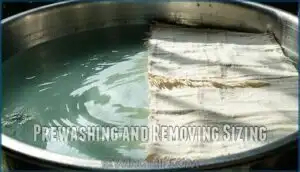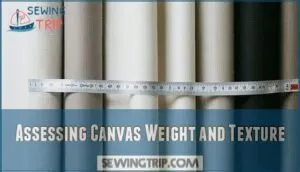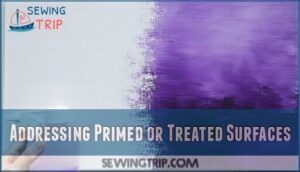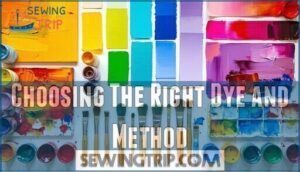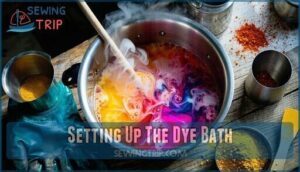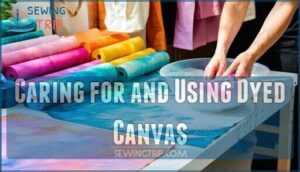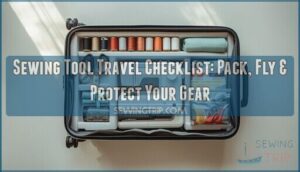This site is supported by our readers. We may earn a commission, at no cost to you, if you purchase through links.
 Yes, you can dye canvas, but success depends on the fabric type. Natural fiber canvases like cotton and linen absorb dye beautifully, creating vibrant, lasting colors. Synthetic blends often produce patchy results, while primed canvas resists dye completely.
Yes, you can dye canvas, but success depends on the fabric type. Natural fiber canvases like cotton and linen absorb dye beautifully, creating vibrant, lasting colors. Synthetic blends often produce patchy results, while primed canvas resists dye completely.
The secret lies in proper preparation—prewash your canvas to remove sizing, choose fiber-reactive dyes like Procion MX for natural fibers, and use techniques like immersion or tie-dye methods. Lighter canvas weights take dye faster than heavy weaves, and weave density affects color distribution.
Your canvas choice makes or breaks the project, but with the right approach, you’ll transform plain fabric into stunning custom pieces.
Table Of Contents
Key Takeaways
- You’ll get the best results with natural fiber canvas – cotton and linen absorb dye beautifully, while synthetic blends create patchy, uneven colors that’ll frustrate your project
- Preparation makes or breaks your dyeing success – you must prewash your canvas to remove sizing and avoid primed surfaces, which completely resist dye penetration
- Choose fiber-reactive dyes like Procion MX for vibrant, lasting colors – these create permanent bonds with natural fibers and won’t fade or bleed like all-purpose dyes
- Proper technique and additives ensure professional results – use salt for better absorption, maintain consistent water temperature, and agitate regularly for even color distribution
Can You Dye Canvas Fabric?
Yes, you can dye canvas fabric, but success depends heavily on the material’s composition and preparation.
Natural fiber canvases like cotton and linen absorb dye beautifully, while synthetic blends often produce patchy, uneven results that’ll leave you wondering why you didn’t check the fabric content first.
Types of Canvas Suitable for Dyeing
Canvas fabric types vary substantially in their dyeability. Cotton canvas offers the highest dye absorption, with fiber composition determining color intensity. Natural fibers like cotton and linen canvas accept dyes readily, while blended fabrics show uneven results.
Weight considerations matter—lighter canvas material absorbs faster than heavy weaves. Primed canvas resists dye penetration completely. Weave density affects color distribution across your canvas surface.
Canvas is known as a heavy-duty material due to its plain-weave construction. It has natural fibers like cotton and is notable for its color intensity.
Natural Vs. Synthetic Canvas Results
Your fiber composition determines everything when dyeing canvas fabric. Natural cotton and linen canvas absorb dye beautifully, creating vibrant colors with excellent dye uptake.
Synthetic canvas resists most dyes, requiring specialized products like DyeMore for proper bonding. Blended fabrics produce uneven results since natural and synthetic fibers accept dye differently, often creating interesting texture changes and mottled color fastness patterns.
For synthetics, it’s vital to take into account water temperature control for desirable results, considering the overall dye uptake.
Limitations and Considerations
Several factors can trip up your dyeing project. Oil-primed or acrylic-primed canvases resist dye absorption, creating uneven dyeing patterns. Pre-existing stains might show through or interfere with stain masking efforts.
Color fading occurs with direct sunlight exposure, while texture changes happen with certain dye choices. Color bleeding affects subsequent washes unless you use colorsafe detergents.
Redyeing becomes necessary when dye lots vary unexpectedly.
Preparing Canvas for Dyeing Success
Proper preparation sets the stage for vibrant, even color results when dyeing canvas.
You’ll need to prewash your fabric and assess its texture to avoid patchy, disappointing outcomes that’ll make you want to toss the whole project. Proper preparation helps to avoid disappointing outcomes.
Prewashing and Removing Sizing
Before prepping the canvas for dyeing, you’ll need to strip away the manufacturer’s sizing—that invisible barrier preventing even dye absorption. Think of sizing as fabric’s protective coating that must go.
- Wash canvas fabric in warm water with mild detergent
- Skip fabric softeners during sizing removal process
- Rinse thoroughly until water runs completely clear
- Air-dry the prepped canvas to avoid heat-setting residues
Residue effects from inadequate preparation create patchy, uneven dyeing results that’ll frustrate your project goals. The removal of the manufacturer’s sizing is crucial for achieving even dye absorption, and skipping this step can lead to inadequate preparation and frustrate your project goals.
Assessing Canvas Weight and Texture
Before diving into dye selection, you’ll need to evaluate your canvas material’s physical characteristics. Understanding Weight and Absorption patterns helps predict dye uptake, while Texture and Dyeing compatibility affects color evenness. Canvas Flexibility and Weave Density determine soaking times needed for uniform results.
| Canvas Weight | Dyeing Time Needed |
|---|---|
| Light (under 8 oz) | 30-45 minutes |
| Medium (8-12 oz) | 1-2 hours |
| Heavy (12-16 oz) | 2-4 hours |
| Extra Heavy (16+ oz) | 4+ hours |
Fabric experts recommend testing a small corner first—thick canvas fabric resists penetration, requiring extended processing for complete saturation and maximum Durability Impact. Consider the fabric’s fiber composition to best determine dye suitability.
Addressing Primed or Treated Surfaces
Most store-bought canvas comes primed with acrylic gesso, creating a barrier that blocks dye penetration.
Priming impacts your dyeing canvas success—dye simply sits on the surface instead of soaking into fabric fibers.
This acrylic resistance means you’ll get patchy, weak colors. For proper dyeing, you’ll need finish removal using isopropyl alcohol or solvents, though surface prep can damage canvas weave.
Choosing The Right Dye and Method
Selecting the right dye and application method determines whether your canvas project succeeds or ends up looking like a science experiment gone wrong. You’ll need fiber-reactive dyes for cotton canvas or acid dyes for linen, plus the right technique to match your creative vision, which involves using the correct type of dye, such as fiber-reactive dyes.
Best Dyes for Cotton and Linen Canvas
When dyeing canvas fabric, fiber reactive dyes reign supreme for cotton and linen materials. These powerhouse dyes create permanent bonds with natural fibers, delivering vibrant colors that won’t fade or bleed.
- Procion MX dyes – Top choice for colorfast results on cotton canvas
- Natural dyes – Eco-friendly options like indigo and madder for sustainable projects
- All-purpose dyes – Convenient but less permanent than fiber reactive varieties
- Acid dyes – Not recommended for canvas; better suited for protein fibers
- Specialty dye brands – Jacquard and Dharma Trading offer professional-grade options. For the best results, remember to wash cotton beforehand to remove any impurities.
Immersion, Tie-Dye, and Spray Techniques
Three powerful methods transform canvas fabric: immersion benefits deliver uniform color saturation by submerging the entire piece in a dye bath, ensuring complete dye penetration. Tie-dye patterns create artistic designs through strategic binding and folding techniques. Spray uniformity offers precise control for gradients and stenciled effects.
Each dyeing process requires different fabric dye concentrations. Immersion dye supplies are readily available for canvas projects. Technique combinations reveal endless creative possibilities when dyeing canvas projects, and understanding uniform color saturation is key to achieving the desired effects.
Using Dye Additives for Better Results
Dye additives can transform your canvas from bland to brilliant, giving you more control over the final result. Professional dyers rely on these helpers to achieve consistent, vibrant colors that won’t fade or bleed.
Consider these game-changing additives for your next project:
- Salt Benefits – Enhances dye absorption and creates deeper saturation in cotton canvas
- Soda Ash – Acts as dye activation powder, creating permanent bonds with fiber-reactive dyes
- Dye Fixatives – Prevents color bleeding and extends fabric life, especially with liquid dye
- UV Protection additives – Shield your finished canvas from sun damage and fading
- Dye thickening powder – Controls dye powder spread for precise patterns and Color Enhancement
For specialized applications, consider using specific salt dye products.
Step-by-Step Canvas Dyeing Instructions
Now that you’ve gathered your materials and chosen your dye method, it’s time to transform your canvas into the perfect color you’ve envisioned. Following these step-by-step instructions will help you achieve even, vibrant results that’ll make your finished project look professionally dyed.
Setting Up The Dye Bath
Now you’re ready to transform that dye powder mixture into a working dye solution. Fill your container with enough warm water to fully submerge your canvas, leaving room for movement. The magic happens when you activate your dye with the right water quality and temperature control.
| Dye Bath Component | Recommended Amount |
|---|---|
| Water per yard of canvas | 3 gallons |
| Dye concentration | 1-2 tablespoons powder |
| Water temperature | 140°F (60°C) |
| Salt or soda ash | 1 cup per gallon |
| Container size minimum | 5+ gallons |
Safety measures matter here—wear gloves and work in ventilated areas. Your dye activation powder dissolves better in hot water, creating an even dye bath that’ll give you consistent results across your entire canvas piece.
Agitating and Soaking The Canvas
Once you’ve lowered your canvas into the dye bath, maintain steady agitation frequency by stirring every few minutes. This prevents uneven dyeing and guarantees the dye solution reaches every fiber. Keep water temperature consistent throughout the soaking process.
Container size matters—your canvas needs room to move freely. Most fabrics require 30-60 minutes of soak duration for proper dye activation powder absorption and vibrant results.
Rinsing, Washing, and Color Setting
After soaking, proper rinsing prevents dye bleeding and guarantees color fastness. Remove your canvas from the dye bath and rinse with cold water until it runs clear. This step locks in your Rit Dye results and prepares the fabric for washing. For the best results, consider mild detergent options to protect the dyed canvas.
- Rinse thoroughly with cold water to remove excess dye particles
- Use gentle detergent choice on cold water cycle for first wash
- Check water temperature stays below 86°F to prevent color fading
- Air dry your canvas using proper drying methods to avoid shrinkage
- Test a small corner first to verify successful color setting before full use
Caring for and Using Dyed Canvas
Once you’ve successfully dyed your canvas, proper care guarantees your colors stay vibrant and your fabric remains in great condition for years to come.
The right washing techniques and creative applications will help you get the most out of your newly transformed canvas.
Washing and Drying Tips for Longevity
Caring for your dyed canvas properly extends its vibrant life substantially. Use mild detergents when washing, as harsh chemicals can strip color faster than a toddler removes crayons from walls. Always air dry your canvas to prevent shrinkage and avoid direct sunlight, which causes fading.
| Care Aspect | Best Practice | Why It Matters |
|---|---|---|
| Gentle Detergents | Use mild, color-safe formulas | Prevents color fading and fabric damage |
| Air Drying | Skip the washing machine dryer | Shrinkage prevention and maintains texture |
| Stain Removal | Treat spots immediately with cold water | Preserves overall color integrity |
Creative Project Ideas (Tote Bags, Curtains, Art)
Your freshly dyed canvas opens up countless creative possibilities. Transform ordinary fabric into custom pieces that reflect your personal style through these exciting projects:
- Canvas Tote Bag designs using dip dyeing techniques with Rit Fabric Dye for gradient effects
- Custom Canvas Curtains featuring stenciled patterns over your base dyed color
- Dyed Canvas Art stretched on frames for unique wall hangings and abstract pieces
- Canvas Home Decor including throw pillow covers and table runners in coordinating colors
- Wearable Canvas Art transformed into aprons, jackets, or accessories with artistic flair
Where to Buy Canvas for Dyeing Projects
Canvas fabric hunting isn’t rocket science, but knowing where to look saves time and money. Online retailers like Canvas ETC offer premium canvas fabric with consistent quality and color options. Local fabric stores stock basic canvas material, while art supply shops carry specialized canvas weight varieties.
Don’t overlook thrift stores for affordable drop cloth fabric that dyes beautifully. Many retailers offer options to buy canvas material online, which can be a convenient way to purchase canvas fabric and premium canvas fabric.
Frequently Asked Questions (FAQs)
How long does canvas dye last before fading?
Your dyed canvas typically lasts 6-12 months before noticeable fading occurs, though this depends on sun exposure, washing frequency, and dye quality. UV-resistant dyes extend longevity substantially for outdoor applications.
Can you dye waterproof or water-resistant canvas?
Waterproof canvas won’t accept dye effectively because protective coatings repel water and dye molecules. You’ll need to strip the waterproof treatment first, which compromises the fabric’s water resistance permanently.
Whats the cost difference between dyeing versus buying?
Like choosing between buying a ready-made suit versus tailoring your own, dyeing canvas costs roughly $3-8 per yard versus buying pre-colored canvas at $12-25 per yard, making DIY dyeing substantially cheaper for larger projects.
How do you fix uneven dye results?
Try overdyeing with a darker shade, spot-treat light areas with concentrated dye solution, or use fabric markers for touch-ups. Next time, make certain of thorough fabric saturation and consistent agitation.
Can you overdye dark canvas to lighter colors?
Unfortunately, you can’t overdye dark canvas to lighter colors—dye only adds pigment, never removes it.
Think of it like adding paint layers; you’re building up color, not stripping it away, which can be understood as dye only adds pigment, never removes it.
Conclusion
Ready to transform your plain canvas into something spectacular? Whether you’re creating custom tote bags, vibrant curtains, or artistic masterpieces, you now know that yes, you can dye canvas successfully with the right approach.
Natural fiber canvases offer the best results, while proper preparation and quality fiber-reactive dyes guarantee lasting color.
Remember to prewash, choose appropriate techniques, and follow proper care instructions. Your next creative project awaits—grab some canvas and start experimenting with colors that reflect your unique style, using the right approach.
- https://docs.google.com/forms/d/1GAQr3Kn1cURCVHUA82hAga1Wv8DCH0IuqDLRUrOpN7M/viewform?ts=63f4f653&entry.1515682415=https://www.merriam-webster.com/dictionary%2Fcan
- https://premium.britannica.com/mw-unabridged/?utm_source=mw&utm_medium=inline-def&utm_campaign=evergreen
- https://grammar.collinsdictionary.com/us/easy-learning/when-do-you-use-can-and-could-in-english
- https://tr.thefreedictionary.com/kutu
- https://es.thefreedictionary.com/esforzar

